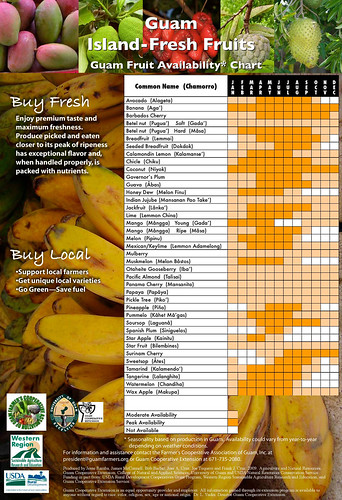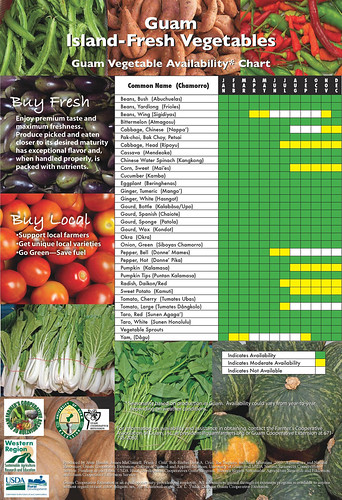Print version of this lesson plan and attachments.
Let’s Eat Fresh Vegetables and Fruits
By Bo Ra Euh
Elementary School Educator, Baltazar P. Carbullido Elementary School, Guam
About This Lesson
The following lesson plan was developed as part of the Culturally Sustaining Education: The Micronesian Context professional development workshop held 24-26 July 2018. The workshop was held in Guam and made possible by the Center for Pacific Islands Studies at the University of Hawai’i at Mānoa in partnership with Chaminade University of Honolulu’s Center for Teaching and Learning, the Department of CHamoru Affairs and the Senator Antonio Palomo Guam Museum and Educational Facility, the College of Micronesia, Alik Translation Services, and Guampedia. All lesson plans developed as part of this series were authored by a Guam-based educator with contributions from workshop facilitators.
Subjects
Health, Language Arts, Mathematics
Grade-level
Kindergarten
Elementary, 2nd Grade
Time required
45 minutes a day for 5 days
Materials required
- Local fruits and vegetable picture cards
- Guam Island-Fresh Fruits poster
- Guam Island-Fresh Vegetable poster
- Eat Colors, Be Healthy poster
- Coloring art supplies
- Fresh local fruits and vegetables (if in season)
- Children’s story books on fruits and vegetables
- Family Project: Let’s Eat a Rainbow!
Related links
Lesson Plan
Objectives
- Students will develop skills to examine a group of vegetables and fruits, and sort them into (1) Vegetable Group and (2) Fruit Group with 90 – 95% accuracy.
- Students will list at least three reasons why we have to eat fresh vegetables and fruits daily for our health.
- Students will be able to identify at least 10 vegetables and fruits grown on Guam and or in one’s home island/country.
- Students will complete the “Family Project: Let’s Eat a Rainbow” and present it to the class by naming fruit and vegetable in one’s own native language.
- Upon the completion of class presentation, students will participate in a class discussion about the similarities and differences between fruits and vegetables grown in Guam and other islands/countries with 90 – 95% accuracy.
- Students will be able to categorize all fruits and vegetables into seven colors shown on the Healthy Eating Rainbow chart with 90 – 95% accuracy.
- Students will be able to name the colors of the rainbow in CHamoru language with 90 – 95% accuracy.
Questions or Assessment
- What counts as a fruit? What counts as a vegetable?
- What fruits/vegetables have you eaten or never eaten before?
- What vegetable grows under the ground?
- Does this fruit or vegetable grow on Guam?
- What do you call this fruit/vegetable in CHamoru language?
- Why do we need to eat fresh fruits and vegetables?
- Guess which color of fruits/vegetables keeps our heart strong when we eat them? (Red)
- Guess which color of fruits/vegetables is good for our eyes? (Orange and Yellow)
- Guess which color of fruits/vegetables makes our stomach feel better? (Green)
- Guess which color of fruits/vegetables help your brain work well? (Blue and Purple)
- Guess which color of fruits/vegetables keeps your body strong and fight again germs? (White and Tan)
Procedure
Sorting fruit or vegetable
- Teacher will begin the instruction by showing the picture of niyok (coconut) and kamuti (sweet potato) to students.
- Then students will be asked to identify whether the produce shown in each picture card is a vegetable or a fruit.
- Students will also be asked to explain how it was identified as a fruit or a vegetable.
- Teacher will explain to the class the main difference between fruits and vegetables.
- Then teacher will show various pictures of local produce, and continue with the identification game with the class to ensure everyone’s understanding on its main difference.
Introducing the Lesson
Teacher will continue the lesson by explaining the following key concepts of the lesson:
- The importance of eating fresh fruits and vegetables daily by conducting a various read-aloud activities.
- Sorting fruits and vegetables by using picture cards or fresh fruits if available.
- Naming various local fruits and vegetables/finding out where we could get these fresh fruits and vegetables on Guam.
- Learning the CHamoru name of different fruits and vegetables produced on Guam.
- Learning the local name of different fruits and vegetables produced in one’s own island or country.
- Participating in various read-aloud activities to learn about different colors fruits and vegetables can be, and how they help our body in different ways.
Activity
- Sorting Activity: Hand out the picture cards of various fruits and vegetables to students. Have them categorize each picture under following headings: Fruits or Vegetables
- Completing review worksheets or by answering review questions asked after the read aloud activities
- What do you call this fruit or vegetable in your native language?
- Sorting Activity: Use the picture cards showing various fruits and vegetables. Have students categorize each picture under following headings: LOCAL or NOT
- Eating a Rainbow Chart – Family Project to conduct a class presentation
Check for Understanding
- Students will complete various projects/worksheets to display their understanding of the key concepts introduced in the lesson.
- Students will also answer various review questions.
- Teacher will conduct both informal and formal observations while students are participating in various assignments.
Closure
- Upon the completion of the “Family Project: Let’s Eat a Rainbow”, each student will have an opportunity to present one’s own project to the class. The project will answer following two questions:
- What fruits/vegetables are grown in one’s own island or country based on the colors provided?
- What each fruit/vegetable is called in one’s own language?
- Students will discuss about the similarities and difference between vegetables and fruits grown in Guam and other islands/countries.
Colors in CHamoru
Learning how to say the CHamoru word for each color shown in the rainbow below
| CHamoru | English |
|---|---|
| Agaga’ | Red |
| Kulot Kahet | Orange |
| Amariyu | Yellow |
| Betted | Green |
| Asut | Blue |
| Lila | Purple |
| A’paka’ | White |
| Kulot Kueru | Tan |
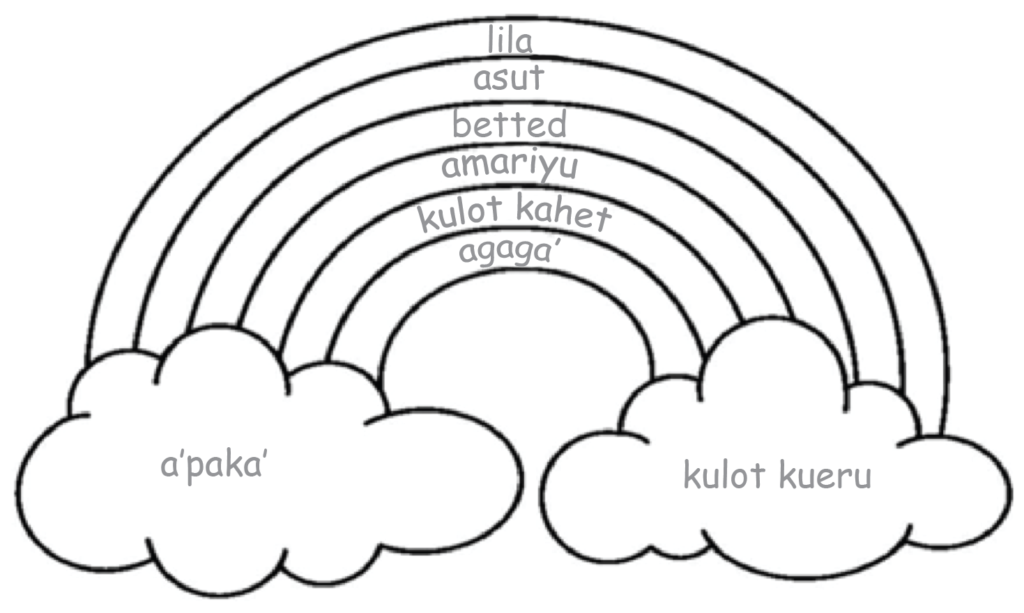
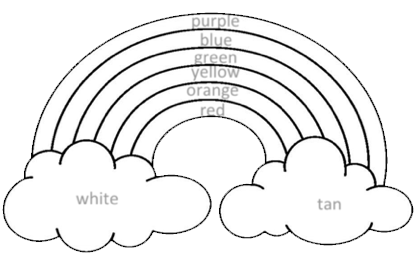
Posters
Family Project
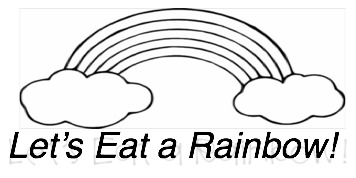
Instructions
Review various fruits and vegetables that are grown locally in your island/country with your child. Have your child select at least one fruit or vegetable for each color group listed in the box below. If possible, print out the picture of each fruit/vegetable selected. You can also have your child draw its picture. Practice with your child on how to say the local name of each fruit/vegetable selected for your child’s class presentation. Our class will be happy to learn on how to say the local name of each fruit/vegetable in your child’s project.



